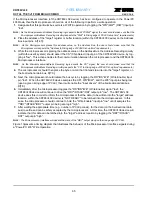
xr
PRELIMINARY
XRT86VL38
REV. P1.0.6
OCTAL T1/E1/J1 FRAMER/LIU COMBO
60
If the Microprocessor Interface (of the XRT86VL38 device) has been configured to operate in the Motorola-
Asynchronous Mode, then the Microprocessor should do all of the following to perfrom a write operation:
1.
Place the address of the "target" register or buffer location (within the XRT86VL38 device) on the Address
Bus input pins, A[14:0].
2.
While the microprocessor is placing the address value on the Address Bus, the Address Decoding circuitry
(within the user's system) should assert the CS* (Chip Select) input pin of the XRT86VL38 device, by tog-
gling it "low". This action enables further communication between the microprocessor and the XRT86VL38
Microprocessor Interface.
3.
Assert the ALE/AS* (Address Strobe) input pin by toggling it "low". This step enables the "Address Bus"
input drivers, within the Microprocessor Interface block of the XRT86VL38 device.
4.
After allowing the data on the Address Bus pins to settle (by waiting the appropriate "Address Setup" time),
the microprocessor should toggle the ALE/AS* input pin "high". This step causes the XRT86VL38 device
to "latch" the contents of the "Address Bus" into its internal circuitry. At this point, the Address of the regis-
ter or buffer location (within the XRT86VL38 device), has now been selected.
5.
Afterwards, the microprocessor should indicate that this current bus cycle is a "Write" operation by toggling
the WR*/R/W* (R/W*) input pin "low".
6.
The microprocessor should then place the byte or word that it intends to write into the "target" register, on
the bi-directional data bus, D[7:0].
7.
Next, the microprocessor should initiate the bus cycle by toggling the RD*/DS* (Data Strobe) input pin
"low". When the XRT86VL38 device senses that the WR*/R/W* (R/W*) input pin is "high" and that the
RD*/DS* (Data Strobe) input pin has toggled "low", it will enable the "input drivers" of the bi-directional data
bus, D[7:0].
8.
Immediately after the microprocessor toggles the RD*/DS* (Data Strobe) signal "low", the XRT86VL38
device will continue to drive the "RDY*/DTACK* output pin "high". The XRT86VL38 device does this in
order to inform the microprocessor that the data (to be written into the "target" address location, within the
XRT86VL38 device) is "NOT READY" to be latched into the microprocessor. In this case, the microproces-
sor should continue to hold the "Data Strobe" (RD*/DS*) input pin "low" until it detects the "RDY*/DTACK*
output pin toggling "high".
9.
After waiting the appropriate time, for the data (on the bi-directional data bus) to settle and can be safely
accepted by the microprocessor. At this time, the XRT86VL38 device will indicate that this data can be
latched into the "target" address location by toggling the "RDY*/DTACK*" output pin "low".
10.
After the microprocessor detects the RDY*/DTACK signal (from the XRT86VL38 device) toggling "low", it
can then terminate the Write Cycle by toggling the "RD*/DS*" (Data Strobe) input pin "high".
N
OTE
: Once the user toggles the "RD*/DS* (Data Strobe) input pin "high", then the following two things will happen.
3.
The XRT86VL38 device will latch the contents of the bi-directional data bus into the Microprocessor Interface
block.
4.
The XRT86VL38 device will terminates the "Write" cycle.
Figure 7presents a timing diagram that illustrates the behavior of the Microprocessor Interface signals, during a
"Motorola-Asynchronous" Write Operation.
















































